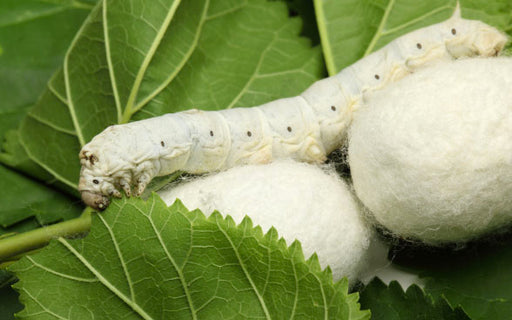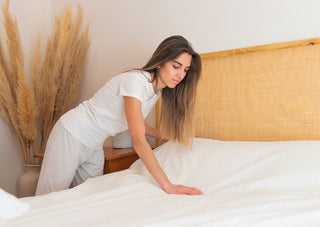Where Does Silk Come From?

Origins of Silk
When you look at a bolt of silk and the way light plays over its supple sheet, it seems a work of magic that such an expensive-looking product comes from the cocoons of a caterpillar.
There’s no way to know who first saw a caterpillar cocoon and whether they envisioned flowing sheets of the shining splendour that we call silk or who discovered it was one of the world’s strongest natural fibres and could be used to make a textile. Either way, the combination of silk’s sheen and strength is a winning one.
A Brief History of Silk
Known formally as sericulture, silk production has taken many forms throughout the history of trade and into today’s modern textile industry. The earliest we know silk to have been in production goes back over 8,000 years ago. It was found in tombs located in Jiahu, a city in the Henan Province of China.
Although it’s hard to know the exact history of silk given how far back into antiquity its production stretches, legend credits a Chinese empress for its development as a popular textile. Due to its speciality status, the fabric was made for and worn by Chinese royalty and those of their choosing, and they tried to suppress knowledge of how silk was made for many years in order to maintain their corner on the market.
Of course, trade did eventually expand bringing with it the answer to where silk comes from, and different species of caterpillars, insects and arachnids are now cultivated for their silk-spinning abilities in various parts of the world.
What Makes Silk So Special?
There’s no way to know who first saw the cocoon of a caterpillar and whether they envisioned flowing sheets of the shining splendour that we call silk or discovered it was one of the world’s strongest natural fibres and could be used to make a textile. Either way, the combination of silk’s sheen and strength is a winning one.
But, if those facts didn’t sell you on why silk is so special, consider this next fact. Silk doesn’t let go of warmth very easily, so you’ll stay that much warmer if it’s cold — and its absorbency also means it's comfortable to wear in warmer weather, too. Who doesn’t love an all-season champion?
These qualities alone warrant some of the steep prices you encounter when shopping for silk garments, and they’re still not all that goes into why we pay what we do for silk.
How Silk Goes From Cocoon To Clothing

More Than Moths
Most commercial silk can be assumed to come from the mulberry silkworm as that is the most widely used species in modern day silk production. But, other insects or spiders can produce similar filaments that are also used as a type of silk textile. Some especially rare forms of silk are made of filaments extracted from clams!
Wild vs Domestic Silk
The silk industry grapples with the ethics of production frequently, and many producers focus on wild harvesting rather than using a controlled, domesticated environment. This is seen as a more humane and environmentally friendly way of producing and purchasing silk, although other critics of silk cultivation assert that any commercial use of these filaments is unethical.
Filament to Textile
Most methods of harvesting silk result in the death of the creature producing silk filament so that the filament can be extracted, cleaned and spooled. Responding to calls for more ethical treatment during the cultivation of silk, many producers now attempt to minimize the amount of stress present in the process.
Modern Uses
Beyond the closet, silk’s unique properties have made it a viable product for many clinical and industrial uses. As a protein-based fibre, it can be treated and prepared for use as a surgical suture material, but it’s also suitable for use as a parachute. You’ll also find it back in the home and as a popular furnishing fabric.
Are All Silks The Same?
As with anything, where a product is made can often impact the quality of its manufacturing. For silk, this means environment as well as procedure. Even now, silk coming from China dominates the market as it has from the beginning, but places like India and Brazil are also a couple of the other big contenders. Wild or domestic, their conditions seem particularly advantageous to the production of silk.
Although the market for silk has its big players, you’ll find it's still produced in over 60 countries and to varying degrees of quality. You may be tempted to think less popular producers of silk might hold something rare and exotic just waiting to be discovered — but some independent producers can suffer a lack of consistency and cost control. This means you’ll find yourself paying more and not always getting a product that is worth the money.
And, because silk comes from a filament that can be extracted from several different creatures, the assumed value of the textile it produces varies widely. After all, for as common as the mulberry silkworm’s cultivation is, that hasn’t made it the cheapest type of silk on the market in every case.

However, chances are that the more rare you want the source of your silk to be, and the harder it is to extract it and turn it into a fabric for garment-making, the more you’ll be paying. Take the example of the clam — as novel as sea silk is, it has almost entirely disappeared from modern-day production. Most existing pieces are antiques held in a museum, or newly woven as art rather than clothing.
Buying Silk: Best Practices
Due to silk’s popularity, it’s no surprise there are a dozen and one ways cheap manufacturers try to fake the look and feel of silk. But, it’s not actually that easy to be duped if you know what to look for.
First of all, the tag may say one thing, but you’re going to need more than that to be sure in certain cases. There are industry regulations about what can be called silk, but even 100% silk may still contain another fibre interwoven into it — the amount is just so small that it goes undetected, or it’s accepted as low enough not to count.
But, some manufacturers could just have made it through those checks and balances since they’re not always applied evenly across the world. You should give any silk piece a thorough and personal inspection to assess its authenticity.
Look
Sure, looks aren’t everything, but silk does have a singular sort of shimmer to its sheen. This comes from the organic, geometric shape of the silk filament and the change it undergoes when it's spooled into yarn, then woven into a textile. It catches the light in a way that synthetic fibres are too uniform to mimic.

Feel
Of the many features that makes silk stand out from other types of fabrics it is the way it feels to the touch. As shiny as it usually is, it isn’t a slippery sort of smooth. Most silk is woven in such a way that it becomes a type of satin, but the shape of its natural fibres enhances how this particular weave drapes when it's made of silk.
Squeeze
Real silk fibres will feel and sound as if they crunch a little when rubbed together. Don’t worry, you’re not damaging anything (as long as you don’t get too vigorous), this is completely normal. Synthetic blends will lack this quality and feel stiff instead of crisp. This means fake silk will also wrinkle up when you squeeze it, whereas real silk springs back into shape as soon as you let it go. But, if it’s been sitting in a wrinkled pile for a while, don’t expect real silk to be ready for a night out without a little fixing up.

Compare
You should still consider the tag even if you’re fact-checking it with all of these other steps. If, for example, you’re looking at two different silk blouses and one tag says weight silk and the other says pure-dye, you should go with the pure-dye. Weighted silk has been washed with metallic substances as part of the dyeing process, so the life of the fabric suffers. The process of producing pure-dye silk doesn’t damage the silk filament, so it lasts longer.
Burn
Yes, you read that correctly. A good way to test if silk is real is to burn it. But before you think you’re being led astray, just know that you should only burn a small piece of fabric that you’ve trimmed from an inner, unseen part of the garment. If the burnt edges shrivel up fast and feel like hard plastic, there’s either no silk or not enough to matter. Burnt silk smoulders more slowly and leaves an ash that turns into powder. Clearly, you should only do this with an item you’ve purchased already — but keep your receipt, because if you do test it and find it’s synthetic when it was sold as actual silk, you’re due a refund!
Ethical concerns play into certain choices when it comes to buying and wearing silk clothing. If you’re not able to purchase from suppliers who use production methods that align with your principles, you may find that purchasing second-hand silk pieces is a valuable alternative. Some of the environmental concerns associated with silk production are amplified by the use of synthetic replacements that can’t biodegrade, so purchasing second-hand pieces and taking care of them for lifelong use may be considered to have a lesser negative impact, overall.
Cleaning Silk: A Gentle Wash and Dry
A lot of silk may list itself as machine-washable, but you could be better served by handwashing any pieces you think might stain other garments with dye or pieces with intricate embroidery or other hand-sewn details. It goes without saying that antique or heirloom pieces should be treated with even more care, as silk is vulnerable when wet.
That’s right — one of the world’s strongest fibres loses up to 20% of its strength when it's wet. This is true to one degree or another for most natural fibres. Their porous nature means they become saturated easily, thus weakening their structure and the bonds that hold a strand of yarn together.
If you’re experienced with handwashing natural fibre garments already, you know most need lukewarm water and a mild detergent. That’s true for silk, too, as is the no-bleach rule. It’s common to see silk release dye during the wash, so don’t be surprised if that happens — it doesn’t dull the colour of the dried garment.

Like wool, you’ll also want to avoid direct heat drying. You can, however, hang silk to dry in many cases as it's lightweight enough that it doesn’t stretch itself out like wool does. You should still be careful to make sure nothing else is stretching it out of shape as it dries. Avoid ironing silk, but most steam wands are safe enough if you need to remove wrinkles.
Storing Silk: Protect And Prevent
Whether you’re putting a piece up for the week or packing it away for the season, you should make sure you’re treating your silk right so it doesn’t fall prey to the dangers that could hide in a closet. Clothes moths are a challenge for anyone with a fashion-conscious closet that houses a selection of natural fibre items.
Clothes like these need to breathe in order to last, but you want to put them under lock and key to keep them from pets and pests. And, silk presents some particular complications when it comes to preparing these garments for safe storage. Their porosity soaks up the body’s natural oils and perspiration. That’s why silk can yellow so easily when it’s been worn often enough, especially under the arms and around the lower back.
If you’re using all the standard preventative measures like red cedar hangers, disks or balls that you can tuck into your storage nooks and crannies, remember they need to be freshened up with cedar essential oil to remain effective. The same goes for other all-natural products like lavender sachets, but even the more potent clothes moth pheromone traps need to be replaced routinely.
But, no matter how well-stocked you are with insect or clothes moth repellents, you should always take your clothes out of long term storage to check on them and air them out. Ideally, this should be every three months or so, but 2-3 times a year can also work just as well in some cases. The oldest piece of silk still in existence may date back thousands of years, but it didn’t exactly come out of antiquity unscathed. Fashion enthusiasts may wish for their clothes to be the ones showcased in a museum one day, but nobody wants them to look like they’re so threadbare they belong behind protected glass already!

Like cashmere or merino wool, high-quality silk’s functional abilities and luxurious appeal create a demand that can’t be satisfied by synthetic or cheaply made lookalikes. Choose pieces you know come from trusted merchants and manufacturers, then care for those pieces well, and you’ll be rewarded with a wardrobe that never goes stale — figuratively and literally.
Take care of your silk pieces even more with our tips for silk care.
About MothPrevention
MothPrevention® speak to customers every day about their clothes moth issues - clothes moths are a species that are ever increasing and that can cause significant damage to clothes, carpets and other home textiles.
To date, we’ve helped over 250,000 customers deal with their moth problems. We have developed professional grade solutions including proprietary pheromones and trap design engineered to the highest production standards.





